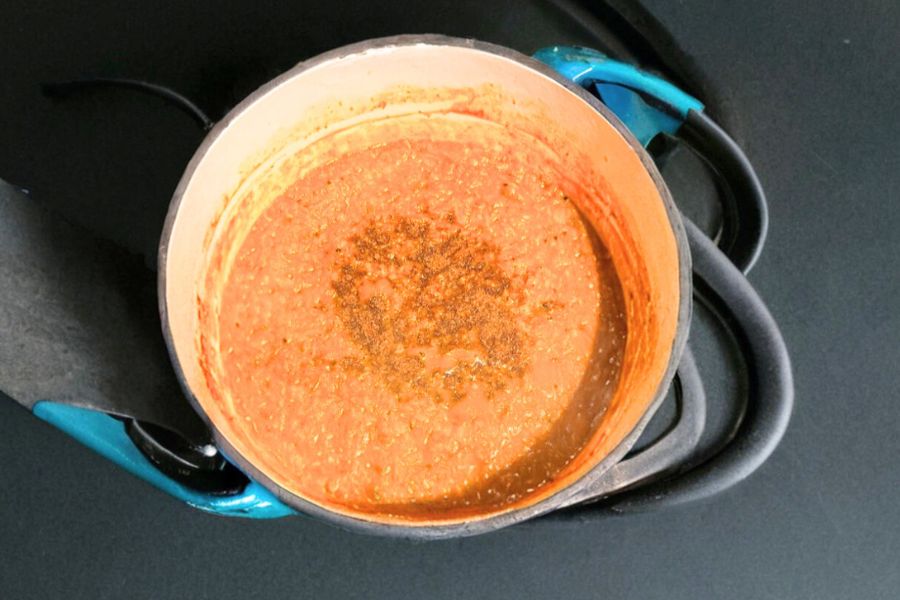Misir Wot is a flavorful Ethiopian lentil stew that stands out for its deeply aromatic spices and comforting richness.
Slow-cooked onions meld with fragrant blends like berbere and mekelesha, creating a complex, layered taste that’s both hearty and satisfying.
This dish is an excellent source of plant-based protein and fiber, thanks to red lentils, which help promote digestion and sustained energy.
With healthy fats from olive oil and minimal saturated fat, it’s a heart-friendly meal perfect for anyone seeking balanced nutrition.
Ideal for everyday cooking, Misir Wot can be made ahead and tastes even better the next day, making it a convenient choice for meal prep.

Whether paired with injera, rice, or veggies, it offers a nourishing, crowd-pleasing option that’s both vegan and allergen-friendly.
Must-Have Tools for Perfect Results
Dutch Oven
Perfect for slow-cooking the lentils and onions evenly, a Dutch oven retains and distributes heat superbly, making it indispensable for stews and soups in any kitchen.
Mortar and Pestle
Essential for crushing cardamom pods and nigella seeds, this tool unlocks the full aroma of spices, offering a fresher, more vibrant flavor than pre-ground alternatives.
Spice Grinder
Ideal for turning toasted whole spices into a fine powder, a spice grinder ensures a well-balanced blend with enhanced intensity, elevating your cooking beyond store-bought mixes.
Garlic Pres
Efficiently minces garlic cloves, saving prep time while releasing maximum flavor, a must-have for any recipe relying on fresh garlic’s pungency.
Large Skillet or Sauté Pan
Great for gently softening onions and building the flavor base, this pan is versatile and perfect for a wide range of stovetop cooking tasks beyond this recipe.

Delicious Ethiopian Misir Wot (Spicy Lentil Stew)
Equipment
- 1 Dutch oven or large pot with lid
- 1 mortar and pestle
- spice grinder or blender
- 1 garlic press1 large skillet or sauté pan
- 1 garlic press1 large skillet or sauté pan
Ingredients
- 1 tbsp cinnamon sticks for mekelesha spice
- 1 tbsp cumin seeds mekelesha spice
- 1 tbsp cloves mekelesha spice
- 1 tbsp black peppercorns mekelesha spice
- 2 whole nutmeg kernels coarsely crushed (mekelesha spice)
- 1 tbsp green cardamom pods seeds removed (mekelesha spice)
- 2 black cardamom pods seeds removed (mekelesha spice)
- 1 tbsp berbere spice mix
- 2 tbsp extra virgin olive oil
- 1 large onion finely chopped
- 1- inch knob fresh ginger grated
- 4 garlic cloves minced
- 1 tsp nigella seeds kalonji, coarsely crushed
- 1½ cups red lentils
- 1 tbsp paprika optional, for color
- Salt to taste
- 2 tbsp fresh cilantro chopped (for garnish)
Instructions
- Prepare the Mekelesha Spice Blend: Start by carefully peeling the green and black cardamom pods using a mortar and pestle to release the seeds, discarding the outer skins. Place the cardamom seeds along with cinnamon sticks, cumin seeds, cloves, black peppercorns, and crushed nutmeg kernels into a dry skillet over medium heat. Toast the spices for 3 to 5 minutes, stirring continuously until they become fragrant and the cumin darkens slightly. Remove from heat, let cool, then grind into a fine powder using a spice grinder or blender. Set aside and store any leftovers in an airtight jar.
- Rinse the Red Lentils: Put the red lentils in a large bowl and rinse them under cold water multiple times, changing the water until it runs clear, usually about five rinses. This removes excess starch and impurities, ensuring the lentils cook evenly and have a clean taste. Drain well and set aside while you prepare the rest of the ingredients.
- Slowly Sauté the Onions: Heat the olive oil in a large Dutch oven or heavy-bottomed pot over medium-low heat. Add the finely chopped onions with a pinch of salt to help draw out moisture. Stir frequently and cook for about 10 minutes until the onions soften and turn translucent. This slow cooking is vital to develop the natural sweetness and deep flavor base for the stew.
- Add Ginger, Garlic, and Spices: Add the grated ginger and minced garlic to the softened onions and sauté for about a minute until fragrant. Stir in a heaping tablespoon of berbere spice and the coarsely crushed nigella seeds. Pour in ¼ cup of water, mix well, cover the pot, and simmer gently for 20 minutes. Stir occasionally and add small amounts of water if the mixture starts sticking, until the onions turn dark brown and paste-like.
- Cook the Lentils: Add the rinsed lentils to the pot along with 2½ cups of water and the optional paprika for color. Stir well and bring the mixture to a boil over medium heat. Lower the heat, cover, and cook for about 10 minutes. For a soupier stew, keep some liquid; for thicker consistency, cook uncovered a bit longer to let the liquid evaporate, stirring often to prevent burning.
- Season and Garnish: Season the stew with salt to taste, then add one to two teaspoons of the freshly ground mekelesha spice blend. Taste and adjust seasoning if needed. Turn off the heat and sprinkle chopped fresh cilantro over the stew as a garnish. Serve warm with injera, rice, or a vegetable side for a complete, satisfying meal.
Notes
- Washing lentils thoroughly reduces starch and helps prevent foaming while cooking.
- Slow-cooking onions until deeply browned builds the rich, sweet flavor foundation essential to this dish.
- Adjust berbere spice quantity based on your heat preference—start with less if you prefer milder flavors.
- Misir Wot tastes better the next day as the flavors develop fully, making it great for meal prep.
- Store leftovers in an airtight container in the refrigerator for up to four days or freeze for longer storage.
- Serve with injera for a traditional experience or with rice and sautéed vegetables for variety.
Chef’s Secrets for Flavor Depth
Achieving the perfect Misir Wot hinges on patience and attention to detail, especially when it comes to developing the base flavors.
The slow sautéing of onions until they are richly browned and almost paste-like is essential—it brings out their natural sweetness and creates the stew’s signature depth.
Don’t rush this step, and keep the heat low to prevent burning.
Toasting and grinding your own mekelesha spice blend elevates the dish tremendously, releasing vibrant aromas that store-bought blends can’t quite match.
When simmering the lentils, keep stirring gently and adjust water as needed to achieve your preferred consistency.
Finally, layering spices thoughtfully rather than all at once allows the complex Ethiopian flavors to shine through beautifully.
Serving Suggestions for Authentic Meals
Misir Wot is traditionally enjoyed with injera, the soft, spongy Ethiopian flatbread made from teff flour, which perfectly complements the rich, spicy lentil stew by soaking up its flavorful sauce.
If injera is unavailable, serving the stew over steamed white or brown rice makes for a delicious and hearty alternative.
Pair it with vegetable sides such as sautéed cabbage, carrots, or potatoes for a balanced meal with contrasting textures and colors.
For a lighter option, fresh greens or a simple salad with lemon vinaigrette provide a refreshing contrast to the stew’s warm spices.
This dish also pairs wonderfully with a cooling yogurt dip or vegan sour cream to balance the heat.
Storage Tips for Freshness Longevity
Misir Wot stores exceptionally well and actually benefits from resting, as the flavors deepen overnight.
Once cooled to room temperature, transfer the stew to an airtight container and refrigerate for up to four days.
When reheating, add a splash of water or broth to loosen the stew if it has thickened too much.
For longer-term storage, freeze the stew in a freezer-safe container or heavy-duty zip-top bag for up to three months.
Thaw overnight in the refrigerator before reheating gently on the stove. Avoid reheating multiple times to maintain the best texture and flavor.
Common Questions About Misir Wot
1. Can I use other types of lentils?
While red lentils are traditional and cook quickly, you can substitute yellow or brown lentils. Just note that cooking times may be longer, and the texture might be different.
2. What if I don’t have berbere or mekelesha spices?
You can use store-bought blends or approximate with smoked paprika, chili powder, cinnamon, and ground cardamom. However, homemade blends provide the most authentic flavor.
3. Is Misir Wot suitable for meal prep?
Absolutely! It tastes even better after a day or two, making it perfect for batch cooking and quick meals during busy weeks.
4. Can I make this recipe oil-free or low-fat?
Yes, you can reduce the olive oil or substitute it with vegetable broth for sautéing, though some fat is recommended to fully develop the flavors.
5. How spicy is Misir Wot?
The heat level depends on the amount of berbere used. You can adjust it to your taste by starting with less spice and adding more gradually.
This recipe has been adapted and simplified from the original version by holycowvegan. We’ve refined the steps for a smoother cooking experience and added helpful notes, nutrition insights, and essential kitchen tools to make it even easier for home cooks.

